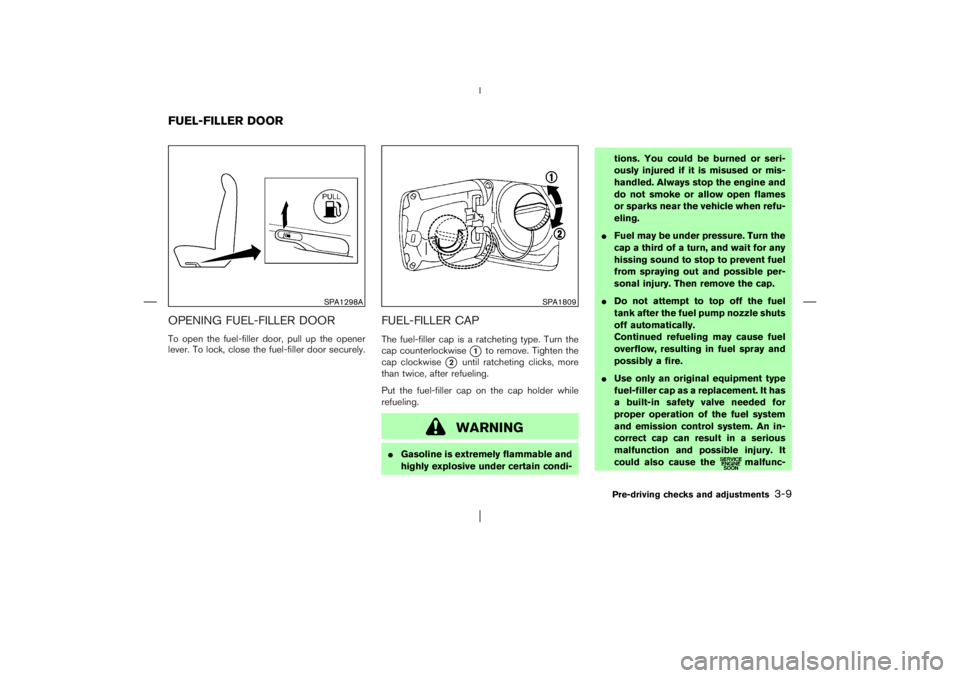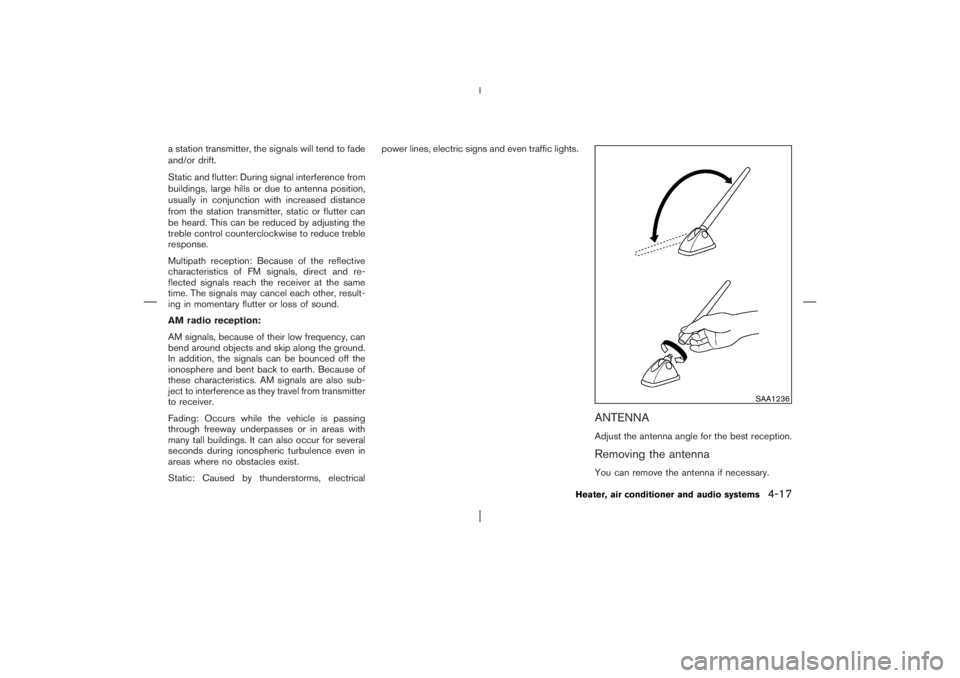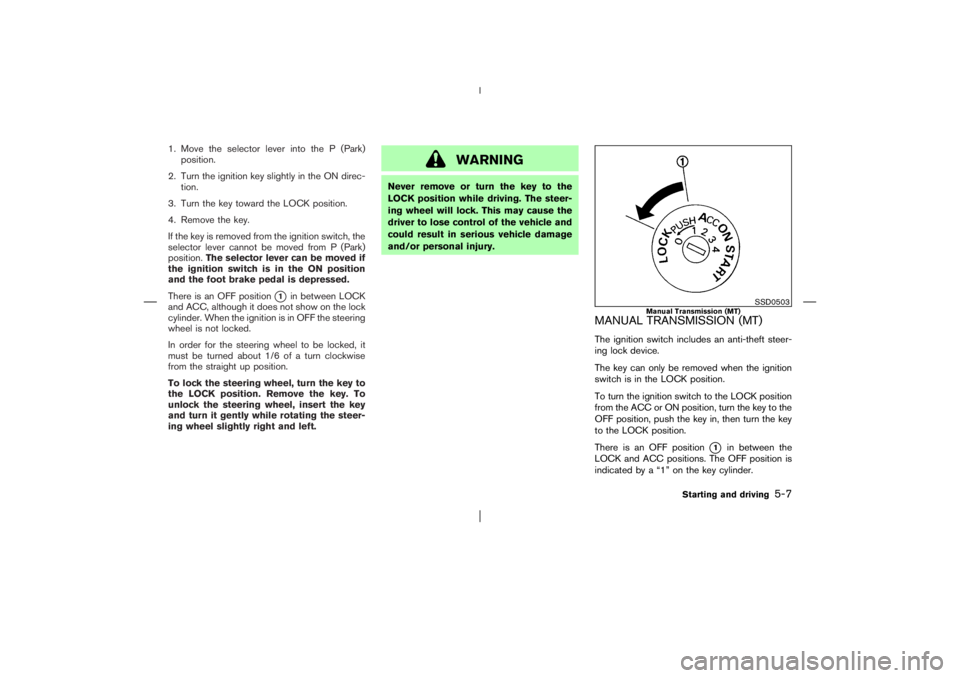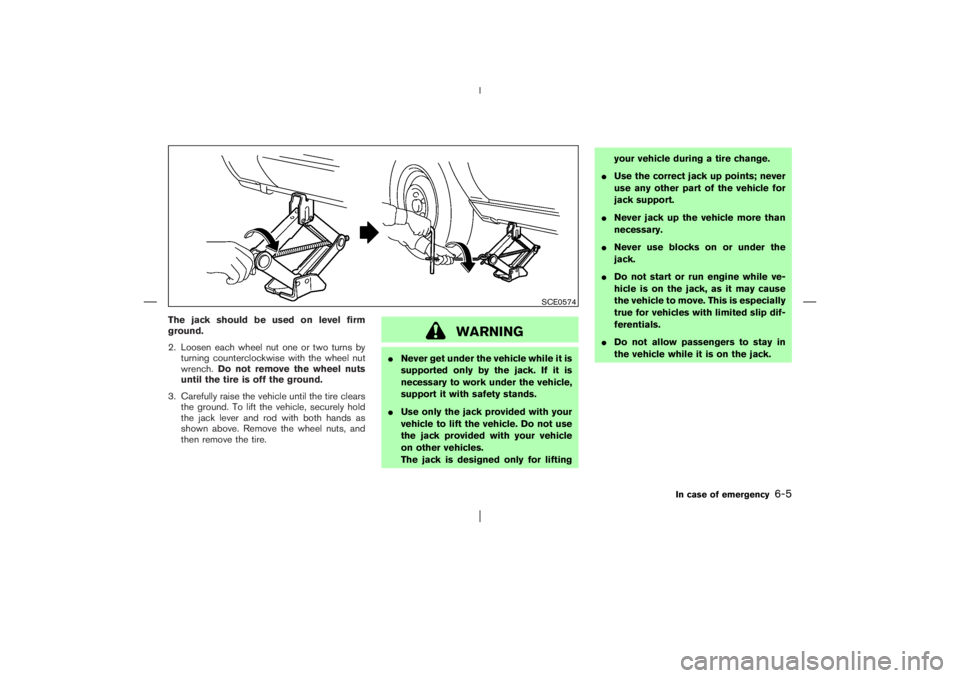Page 114 of 281

OPENING FUEL-FILLER DOORTo open the fuel-filler door, pull up the opener
lever. To lock, close the fuel-filler door securely.
FUEL-FILLER CAPThe fuel-filler cap is a ratcheting type. Turn the
cap counterlockwise
�1
to remove. Tighten the
cap clockwise
�2
until ratcheting clicks, more
than twice, after refueling.
Put the fuel-filler cap on the cap holder while
refueling.WARNING
�Gasoline is extremely flammable and
highly explosive under certain condi-tions. You could be burned or seri-
ously injured if it is misused or mis-
handled. Always stop the engine and
do not smoke or allow open flames
or sparks near the vehicle when refu-
eling.
�Fuel may be under pressure. Turn the
cap a third of a turn, and wait for any
hissing sound to stop to prevent fuel
from spraying out and possible per-
sonal injury. Then remove the cap.
�Do not attempt to top off the fuel
tank after the fuel pump nozzle shuts
off automatically.
Continued refueling may cause fuel
overflow, resulting in fuel spray and
possibly a fire.
�Use only an original equipment type
fuel-filler cap as a replacement. It has
a built-in safety valve needed for
proper operation of the fuel system
and emission control system. An in-
correct cap can result in a serious
malfunction and possible injury. It
could also cause the
malfunc-
SPA1298A
SPA1809
FUEL-FILLER DOOR
Pre-driving checks and adjustments
3-9
�
06.4.14/T30-J/V5.0
�
Page 136 of 281

a station transmitter, the signals will tend to fade
and/or drift.
Static and flutter: During signal interference from
buildings, large hills or due to antenna position,
usually in conjunction with increased distance
from the station transmitter, static or flutter can
be heard. This can be reduced by adjusting the
treble control counterclockwise to reduce treble
response.
Multipath reception: Because of the reflective
characteristics of FM signals, direct and re-
flected signals reach the receiver at the same
time. The signals may cancel each other, result-
ing in momentary flutter or loss of sound.
AM radio reception:
AM signals, because of their low frequency, can
bend around objects and skip along the ground.
In addition, the signals can be bounced off the
ionosphere and bent back to earth. Because of
these characteristics. AM signals are also sub-
ject to interference as they travel from transmitter
to receiver.
Fading: Occurs while the vehicle is passing
through freeway underpasses or in areas with
many tall buildings. It can also occur for several
seconds during ionospheric turbulence even in
areas where no obstacles exist.
Static: Caused by thunderstorms, electricalpower lines, electric signs and even traffic lights.
ANTENNAAdjust the antenna angle for the best reception.Removing the antennaYou can remove the antenna if necessary.
SAA1236
Heater, air conditioner and audio systems
4-17
�
06.4.14/T30-J/V5.0
�
Page 137 of 281
Hold the bottom of the antenna and remove by
turning counterclockwise.
CAUTION
�Be sure that antenna is removed be-
fore the vehicle enters an automatic
car wash.
�Be sure to fold down the antenna
before the vehicle enters a garage
with a low ceiling.4-18
Heater, air conditioner and audio systems
�
06.4.14/T30-J/V5.0
�
Page 138 of 281
FM-AM RADIO WITH CASSETTE
PLAYER AND COMPACT DISC (CD)
CHANGER1. CD LOAD button
2. SEEK/APS REW, APS FF/TRACK
ADJUSTING button
3. AUTOP (Automatic preset) button
4. SCAN tuning button
5. CD PLAY button
6. TAPE PLAY button
7. FM/AM band select button
8. DOLBY button
9. RPT (Repeat) play button
10. RADIO TUNE/FF⋅REW/AUDIO (Bass,
treble, fader, balance) ADJUSTING button
11. CD EJECT button
12. PWR (Power)/VOL (Volume) control knob
13. Audio/Clock display
14. Station and preset (radio)/CD insert or CD
play select button
15. TAPE EJECT button
16. MENU (Bass, treble, fader, balance, clock)
button
SAA0830
Heater, air conditioner and audio systems
4-19
�
06.4.14/T30-J/V5.0
�
Page 139 of 281

Audio main operationHead unit:
The tape deck employs a permalloy head which
allows for improved reproduction of high fre-
quency ranges. Noise is also greatly reduced by
the use of the Dolby NR (Noise Reduction)
system. The auto loudness circuit enhances the
low frequency range automatically in both radio
reception and tape and CD playback.
PWR/Volume control:
Turn the ignition key to ACC or ON, and then
push the PWR/VOL (Volume) control knobwhile
the system is off to call up the mode (radio, tape
or CD) which was playing immediately before
the system was turned off. When no CD or tape
is loaded, the radio will come on. While the
system is on, pushing the PWR/VOL control
knobturns the system off.
To turn the radio off, press the PWR/VOL
control knob.
Turn the PWR/VOL control knobto adjust the
volume.
MENU button:
Press the MENU button to change the selecting
mode as follows.BASS→TREBLE→FADER→BALANCE→
CLOCK ON/OFF→(clock adjustment)→
RADIO→BASS
See “CLOCK” in the “2. Instruments and con-
trols” section for the clock adjustment.
To adjust Bass, Treble, Fader and Balance,
press the MENU button until the desired mode
(BASS, TREBLE, FADER or BALANCE) ap-
pears in the display. Press the TUNE (
,
) or SEEK (
,
) button to adjust
Bass and Treble to the desired level. Use the
TUNE or SEEK button also to adjust Fader or
Balance modes. Fader adjusts the sound level
between the front and rear speakers and Bal-
ance adjusts the sound between the right and
left speakers.
AUDIO
MODEAUDIO CONTROL
ADJUSTING BUTTON
or
Center
position
or
BASS
(bass ad-
justment)BAS −5 BAS 0 BAS +5
TREBLE
(treble
adjust-
ment)TRE −5 TRE 0 TRE +5
FADER
(front/rear
balance
adjust-
ment)FADR5
(FADER
Rear)FAD 0FADF5
(FADER
Front)
BALANCE
(left/right
balance
adjust-
ment)BALL5
(BALANCE
Left)BAL 0BALR5
(BALANCE
Right)Once you have adjusted the sound quality to the
desired level, press the MENU button repeatedly
until the radio, cassette tape or CD display
reappears. Otherwise, the radio, cassette tape
or CD display will automatically reappear after
about 10 seconds.Radio operation
Radio band select:
Pushing the FM/AM button will change the band
as follows:
AM→FM1→FM2→AM
4-20
Heater, air conditioner and audio systems
�
06.4.14/T30-J/V5.0
�
Page 160 of 281

1. Move the selector lever into the P (Park)
position.
2. Turn the ignition key slightly in the ON direc-
tion.
3. Turn the key toward the LOCK position.
4. Remove the key.
If the key is removed from the ignition switch, the
selector lever cannot be moved from P (Park)
position.The selector lever can be moved if
the ignition switch is in the ONposition
and the foot brake pedal is depressed.
There is an OFF position
�1
in between LOCK
and ACC, although it does not show on the lock
cylinder. When the ignition is in OFF the steering
wheel is not locked.
In order for the steering wheel to be locked, it
must be turned about 1/6 of a turn clockwise
from the straight up position.
To lock the steering wheel, turn the key to
the LOCK position. Remove the key. To
unlock the steering wheel, insert the key
and turn it gently while rotating the steer-
ing wheel slightly right and left.
WARNING
Never remove or turn the key to the
LOCK position while driving. The steer-
ing wheel will lock. This may cause the
driver to lose control of the vehicle and
could result in serious vehicle damage
and/or personal injury.
MANUAL TRANSMISSION (MT)The ignition switch includes an anti-theft steer-
ing lock device.
The key can only be removed when the ignition
switch is in the LOCK position.
To turn the ignition switch to the LOCK position
from the ACC or ON position, turn the key to the
OFF position, push the key in, then turn the key
to the LOCK position.
There is an OFF position
�1
in between the
LOCK and ACC positions. The OFF position is
indicated by a “1” on the key cylinder.
SSD0503
Manual Transmission (MT)
Starting and driving
5-7
�
06.4.14/T30-J/V5.0
�
Page 161 of 281

In order for the steering wheel to be locked, it
must be turned about 1/6 of a turn clockwise
from the straight up position.
To lock the steering wheel, turn the key to
the LOCK position. Remove the key.
To unlock the steering wheel, insert the
key and turn it gently while rotating the
steering wheel slightly right and left.
WARNING
Never remove or turn the key to the
LOCK position while driving. The steer-
ing wheel will lock. This may cause the
driver to lose control of the vehicle and
could result in serious vehicle damage
and/or personal injury.KEY POSITIONSThe switch includes an anti-theft steering lock
device.
LOCK (Normal parking position) (0)
The ignition key can only be removed when the
switch is in this position.OFF (1)
The engine can be turned off without locking the
steering wheel.
ACC (Accessories) (2)
This position activates electrical accessories
such as the radio when the engine is not running.
ON (Normal operating position) (3)
This position turns on the ignition system and the
electrical accessories.
START (4)
This position activates the starter motor, starting
the engine.
NISSAN VEHICLE IMMOBILIZER
SYSTEMThe Nissan Vehicle Immobilizer System will not
allow the engine to start without the use of the
registered key.
If the engine does not start using a registered
key (for example, when interference is caused by
another registered key, an automated toll road
device or automated payment device on the key
ring), restart the engine using the following
procedures:
1. Leave the ignition switch in the ON position
for approximately 5 seconds.2. Turn the ignition switch to the OFF or LOCK
position and wait approximately 10 seconds.
3. Repeat steps 1 and 2.
4. Restart the engine while holding the device
(which may have caused the interference)
separate from the registered key.
If this procedure allows the engine to start,
NISSAN recommends placing the registered key
on a separate key ring to avoid interference from
other devices.
5-8
Starting and driving
�
06.4.14/T30-J/V5.0
�
Page 188 of 281

The jack should be used on level firm
ground.
2. Loosen each wheel nut one or two turns by
turning counterclockwise with the wheel nut
wrench.Do not remove the wheel nuts
until the tire is off the ground.
3. Carefully raise the vehicle until the tire clears
the ground. To lift the vehicle, securely hold
the jack lever and rod with both hands as
shown above. Remove the wheel nuts, and
then remove the tire.
WARNING
�Never get under the vehicle while it is
supported only by the jack. If it is
necessary to work under the vehicle,
support it with safety stands.
�Use only the jack provided with your
vehicle to lift the vehicle. Do not use
the jack provided with your vehicle
on other vehicles.
The jack is designed only for liftingyour vehicle during a tire change.
�Use the correct jack up points; never
use any other part of the vehicle for
jack support.
�Never jack up the vehicle more than
necessary.
�Never use blocks on or under the
jack.
�Do not start or run engine while ve-
hicle is on the jack, as it may cause
the vehicle to move. This is especially
true for vehicles with limited slip dif-
ferentials.
�Do not allow passengers to stay in
the vehicle while it is on the jack.
SCE0574
In case of emergency
6-5
�
06.4.14/T30-J/V5.0
�